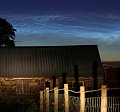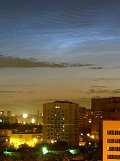| |
| |
Photographer,
Location |
Images |
Comments |
|

|
Danny
Ratcliffe,
Dolwen, Nr Colwyn Bay. North Wales, UK
Jul. 4, 2008 |
#1 |
Currently
enjoying the recent displays of nlcs. This was the second
time in a week of seeing them. Took photos around 1 am,
which I spotted over this very old stone shed in the middle
of a field. The shed serves as a stable for two young Shire
Horses and thought it would make a good foreground to a
lovely nlc display. the nlcs then quickly faded to the horizon.
350D SLR F4, EXP 15 secs ISO 400. |
|

|
Oleg
Pomogaev,
Moscow, Russia
Jul. 5, 2008 |
#1 |
Again
NLC over Moscow. Canon A710 IS digital camera on the tripod.
IS0 200, panoramic image with exposition 6 sec. |
|


|
Bruce
McCurdy,
Edmonton, Alberta, Canada
Jul. 3, 2008 |
#1,
#2, #3,
#4, #5,
#6, more |
No
truth to the rumour that there are no noctilucent clouds
in Canada. After a slow start to the season, I have now
observed displays on 8 different nights, including 6 of
the last 7. Last night's display was bright in places, focussed
in a 10 degree-wide brilliant quilt. It had a spectacular
latticework structure throughout the night, gradually becoming
absolutely gargantuan in scope, ultimately covering pretty
much the entire northern half of the sky, from E to W horizon,
bright up to about 60 degrees altitude and (faintly) right
up to the zenith. The southern half of the sky completely
clear. Weird thing about this display was that the NLC was
alternately bright and dark, with billows of unlit clouds
presumably hanging a bit too low to catch the sunlight.
Rather than foreground tropospheric clouds these dark billows
were clearly part of the same structure as the bright parallel
bands that seemed to support them. I counted as many as
30 of these gently curving horizontal bands. Through these
at pretty much right angles penetrated some still-brighter
rays, which emanated from the NE and diverged in broad bands,
some soaring high and others flattening out near the opposing
horizons. The rays gradually diminished in brightness and
petered out like the tail of a comet--where exactly?--crossing
some vague threshold of resolution. One ray extended a full
60 degrees into the NW and had me drawing comparisons to
Hyakutake.
Camera:
Finepix S5200 More to come |
|

|
Michael
Olsen,
Dronninglund, Denmark, Northern Europe.
Jul. 4, 2008 |
#1,
#2, #3,
more |
Photographs
taken on the early morning of July 4th 2008, in Dronninglund,
Denmark with an Olympus E-500, ASA 200, various shutter
speeds, from 2 sec to 10 sec. The sky was illuminated even
more than on July 2nd. Muc more "crab-like" structures,
and very clear wavestuctures. The NLCs spread out most of
the horizon from east to west at 2.30 am, and at least 60
degrees above horizon. A beautiful display of nature, just
as on July 2nd. |
|

|
Jacob
Kuiper,
Steenwijk, northern part of the Netherlands.
Jul. 2, 2008 |
#1,
#2, more |
Astonishingly
widespread NLC display! It’s the best NLC display of this
season so far. Very bright and waving patterns were visible.
Extremely rapid changing in form. A double wave structure
above the northwesterly horizon changed so rapidly that
even in a few seconds you could detect these changes of
cloud structure. Another astonishing fact was the widespread
character of this display. At 0130 UTC, almost 2 hours before
sunrise the normal small band over the northern horizon
contained visible NLC structures. Half an hour later it
had spread already over the whole northern half of the visible
sky. Again half an hour later, around 0230 UTC well-defined
structures appeared in more and more blue sky in the southern
parts of the sky. My last observation was around 0240 UTC
(35 minutes before sunrise). At that moment with the naked
eye small NLC structures could be spotted 5 –10 degrees
above the southsouthwestern horizon (one contrast enhanced
image shows these clouds). In fact this means that these
cloud particles are drifting somewhere over the Belgian/French
border, far south of the Netherlands. A few years ago I
spotted NLC’s at 40 degrees height above the southern horizon,
but never at a lower height in opposite sunrise direction.
This case of July 2nd is my new record. In fact this explains
also the rare event that people in northern France have
seen NLC’s so clearly at their very southern (NLC) latitude!
Images taken with Minolta-Dimage Z3, exposure time 15 sec
at 50 ASA initially, later 1,6 second 50 ASA. |
more
images (July 4): from
Michal Laszczynski of Gdynia, Poland; from
Karel Dewaele of Stavele, West-Vlaanderen, Belgium; from
Joanne Blundell of Liverpool, UK; from
Raymond Westheim of Oss, The Netherlands; from
Richard Fleet of Pewsey Vale, Wiltshire, England; from
Jamie Haffenden of Near Margate, Kent; from
David of Cerisiers, Bourgogne, France; from
Richard M Haw of Glossop, Derbyshire, England; from
Kain Prestwood of Bridgnorth,Shropshire; from
Martin Stirland of Winterton On Sea, Norfolk, England; from
Marcin Makowski of Szubin, Poland
more
images (July 3): from
Tarmo Tanilsoo of Laguja, Estonia; from
Ian Brantingham near Banff, Scotland
more
images (July 2): from
Martin Masek of Liberec, Czech Republic;
|
|







